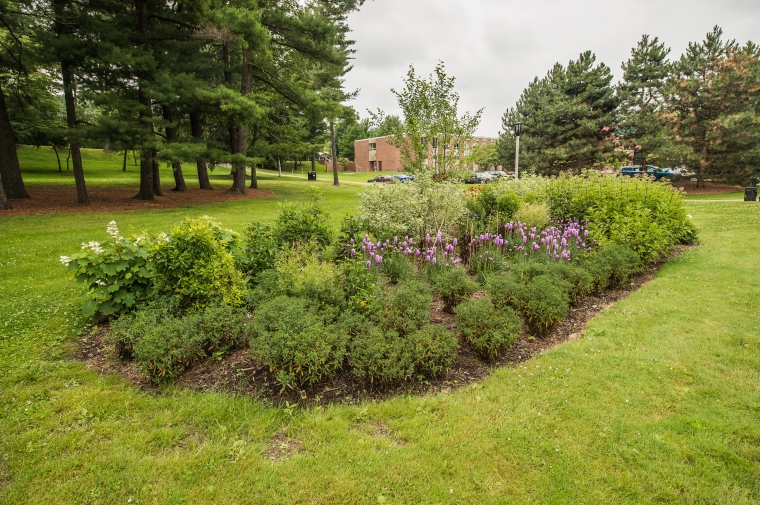By Steve Orbanek
Marketing Communications Specialist, Penn State Behrend
You’ve probably heard of rain gardens, but do you know what they are?
At Penn State Behrend, they are a significant part of the college’s best management practices for storm water efforts.
The college’s two rain gardens — one between Fasenmyer and Hammermill buildings, and one to the east of Nick, near College Drive — sit lower than the surrounding lawn and act as basins to catch and slowly absorb rain water, helping reduce potential flooding during storms and filtering pollutants from storm water runoff that would otherwise enter Four Mile Creek and, eventually, Lake Erie. Storm water runoff is considered one of the nation’s main sources of water pollution.
The rain gardens were planted in 2012 with a $36,495 Growing Greener grant from the Department of Environmental Protection awarded to Ann Quinn, lecturer in biology.
According to Quinn, the gardens have been cut back for the fall, but they grew well this past season. She attributed the successful growth in part to the compost, which is mixture of food waste from Dobbins Dining Hall and leaf matter from the wooded areas on campus, added to the gardens.
The gardens do more than just help with storm water runoff. They are also butterfly way stations and certified pollinator gardens. When choosing what to plant in the garden, Quinn said students researched native plants that fit the three zones — wet, moist, and dry — of a rain garden and also filled the criteria for pollinator and butterfly certifications.
Plants in the college’s rain gardens that are tolerant of standing water include cardinal flower, New England aster, several varieties of Joe Pye weed, swamp milkweed, and cinnamon fern.
Some plants in the garden thrive in areas that hold several inches of water during and immediately after a rain event, but is otherwise dry. Plants in these areas need to be draught tolerant, but also handle water well, too. Plants in the garden that fall into this category include black-eyed Susan, false sunflower, kobold, and summer sweet.
Quinn said that every plant in the garden grew beyond expectations.
“The Joe Pye weed spread well, and there are plans to transplant some of it to other wetland areas on campus,” she said. “The milkweed was a beautiful addition and a very important plant to include for Monarch butterflies, who migrate to the Erie area annually.”
If you missed the gardens this summer, don’t worry, they’ll be abloom again in the spring. And the bees and butterflies will be there to greet you!
Until then, here are some photos to enjoy:

